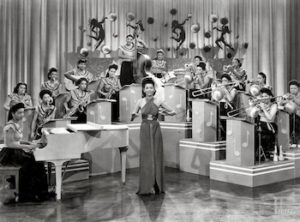
Int. Sweethearts of Rhythm, 1940
*This date is International Jazz Day, and in 1937, the International Sweethearts of Rhythm band was celebrated.
They were an interracial women's band in the United States. During the 1940s, the band featured some of the best female musicians of the day. They began at the Piney Woods Country Life School in Meridian, Mississippi, as the Swinging Rays of Rhythm. Original members were Helen Jones-Woods (trombone), Willie May Wong (saxophone), Pauline Braddy (drums), and Anna Mae Windburn (vocals). Later, saxophonist Viola Burnside and trumpeter Ernestine Tiny Davis joined them, playing swing and jazz. They eventually relocated to Virginia.
Arrangements started with Eddie Durham and Jessie Rock. They went on a national circuit that included the Apollo Theater in New York City, the Regal Theater in Chicago, and the Lincoln Theater in Washington, DC. After a performance in Chicago in 1943, the Chicago Defender announced the band was "one of the hottest stage shows that ever raised the roof of the theater!" They have been labeled "the most prominent and probably best female aggregation of the Big Band era."
The International Sweethearts of Rhythm played big-band jazz that cooks. "The Jubilee Sessions," originally recorded for radio broadcasts aimed toward America’s Black soldiers serving from 1943 to 1946, provide a rare opportunity to hear these women play. The Sweethearts did not get as much exposure to mainstream audiences in the South as the all-white, male big bands of their day because of their racial makeup and the atmosphere of violent racism in that region. When they did tour the Deep South, the three or four white women in the group would paint their faces dark so the police would not remove them from the bandstand and arrest them.
During the American feminist movements of the 1960s and 1970s, the International Sweethearts of Rhythm regained popularity. Antionette Handy, the flutist, was one scholar who documented the story of these non-white female musicians. The band was among the first marketed as women's music. There has also been considerable scholarship regarding their name's "International" aspect. According to one jazz historian, the band membership included "Willie Mae Wong, Chinese saxophonist; Alma Cortez, Mexican clarinet player; Nina de LaCruz, Native American saxophonist; and Nova Lee McGee, Hawaiian trumpet player. They were all children of mixed parents; the rest were African American."
A publicity poster for the band's September 1940 performance in Emporia, Virginia, included the text "America's Greatest Female Band, The International Sweethearts of Rhythm, In Whose Veins Flow the Blood of Many Races: Indian, Mexican, Chinese, Negro". The first white musicians joined in 1943, and there were also several lesbians in the band. In 2011, six of the band's surviving members donated memorabilia and artifacts from their touring years to the National Museum of American History. The ceremony marking the donations was the kick-off event of the Smithsonian Institution's Jazz Appreciation Month, and the band members received a standing ovation from attendees.
The group exemplifies how intersectionality worked in creating a cultural shift in America. In 2012, the compilation album International Sweethearts of Rhythm: Hottest Women’s Band of the 1940s was selected by the Library of Congress for preservation in the National Recording Registry for being "culturally, historically, or aesthetically significant."